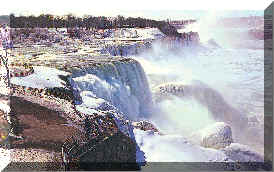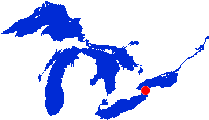 Outdoors Niagara exclusive
Outdoors Niagara exclusive Outdoors Niagara exclusive
Outdoors Niagara exclusive |
A Great
Niagara River Fishing Story
by Mark Daul
PART 3
The Upper Niagara
River where
it empties from Lake Erie is another story in itself. Itís history is as rich
as the Lower Niagara and some of the most recent stories of it's history just
goes back to the 1920ís when prohibition took over in this country. History
shows the river being a source for illegal booze filtering into this country
from Canada. Canada at the time had no prohibition. This was the legendary Al
Caponeís heyday! Even today recreational divers and collectors gather
whisky bottles that were dumped overboard because of fear of apprehension by
authorities. Some of those bottles found even still contain some of that illegal
booze!
Sturgeon: The Sturgeon is another part of
the Upper Niagara History. Some years back in the 30ís, 40ís and as late as
the 50ís, sturgeon were abundant and to locals it was a means of many peoples
livelihood. Trapping and catching sturgeon was as common in those days as going
out and catching a muskellunge today. Possession of sturgeon today, is strictly
illegal in New York State waters.
Muskellunge brings
another story in here. "Muskies" are abundant in the Upper Niagara,
abundant meaning your chance of latching into a 40 inch plus muskie is as good
as anywhere in the United States, and in most instances better than most
places. "Muskie" is the unchallenged abbreviated name the locals call
the muskellunge. Muskie are a highly prized fish anywhere, and catch and release
is more popular than keeping one.
[TOP]
Bass. [Smallmouth]
Opening day, bass fishermen have a heyday where everyone can come home with a
limit of bass all way above the legal size. This continues all around the Upper
River all summer. In 1995, the New York State record smallmouth bass was caught
in Lake Erie near where it empties into the Upper Niagara. That bass tipped the
scales at 8# 4oz. and that record will be broken in the Upper Niagara some day.
It's been close, but close don't count only in horseshoes.
Walleye. Trophy
walleye have been caught through the years and the Ontario record walleye was
pulled out of the Upper Niagara near Fort Erie Ontario. It tipped the scales at
22.2# and measured 36.5" long!
The Upper Niagara
River page will be updated in the near future to include more of the exciting
Upper River fishing and the stories of the Islands.
[TOP]

This is what Niagara Falls, the "Thundering
Waters" looks like in the dead of winter. Notice the observation area with
the railing around it in the forefront. This could quite possibly be the area Father
Louis Hennepen first observed and wrote about in his early writings in 1683.
The ice build-up is from the mist that rises and freezes. Looking to the right
you can see some of the mist rising from the Canadian Horseshoe Falls and on the
far right is the mighty Niagara River in all its winter beauty. The ice cover
you see goes from shore to shore and is actually jammed there until the spring
thaws. About 10 miles down river at this time of year is when the greatest
steelhead fishing on earth is taking place. For the most part this stretch is
reasonably clear of solid ice. No, Niagara Falls doesn't stop flowing at any
time. [TOP]

The 5 Great Lakes are Shown here. The red dot is where the Niagara River is. The Niagara River connects the two Great Lakes of Erie and Ontario. The river flows northward, empties into Lake Ontario and to the St. Lawrence River where it empties into the Atlantic Ocean. Niagara Falls forms a natural fish barrier for fish traveling upriver but many fish survive the drop over the Mighty Cataracts creating multiple species of freshwater fish available in the Lower Niagara..